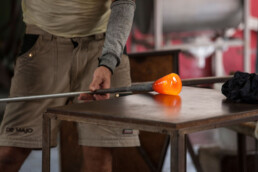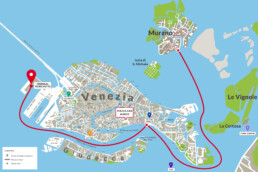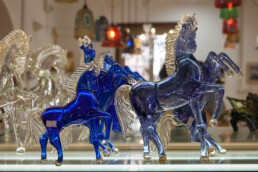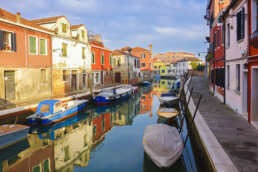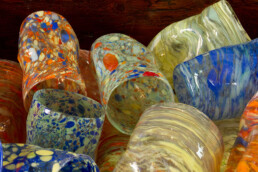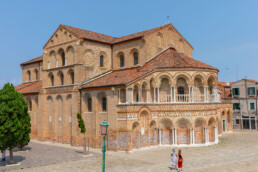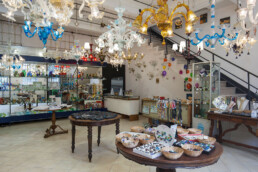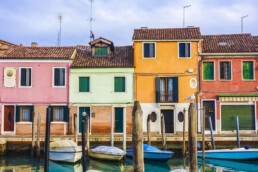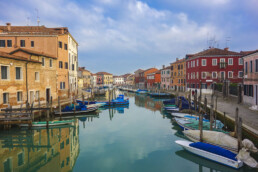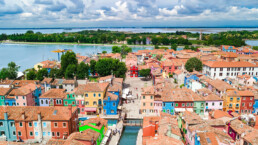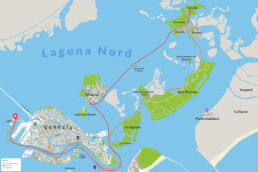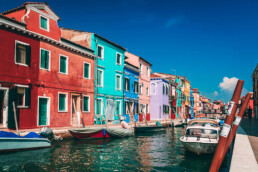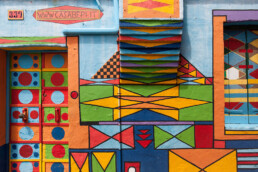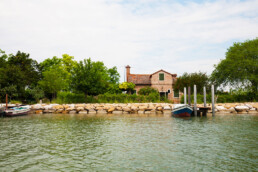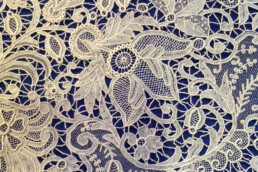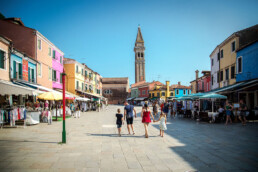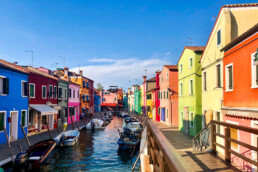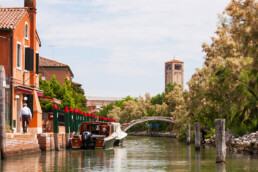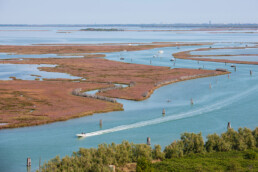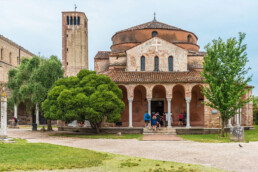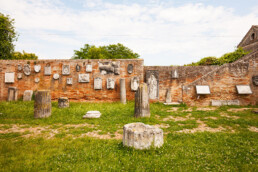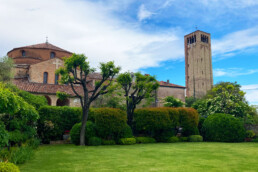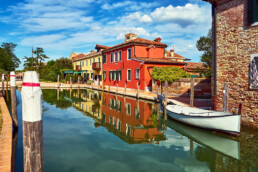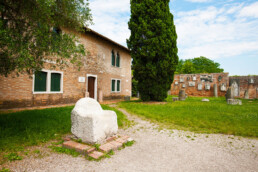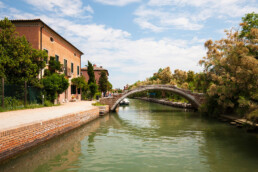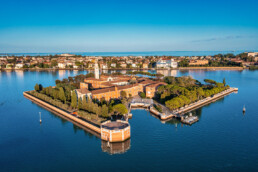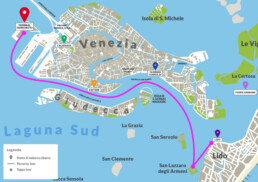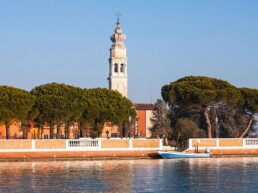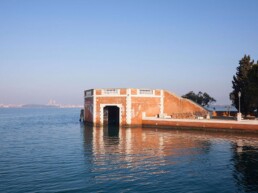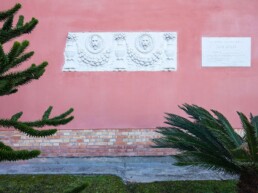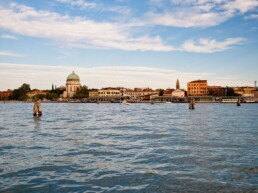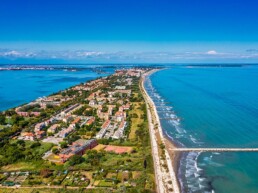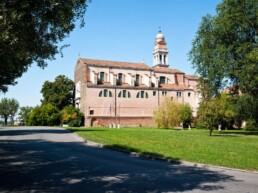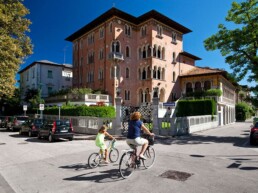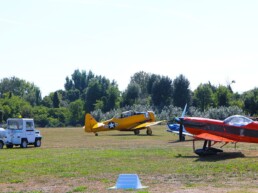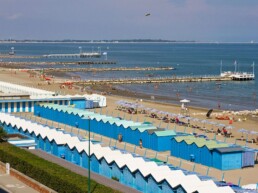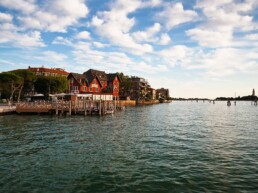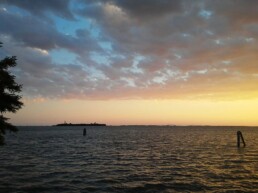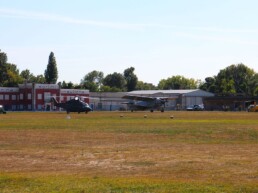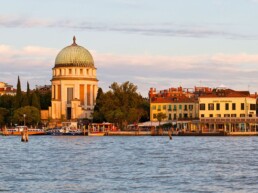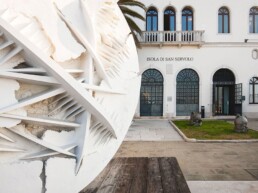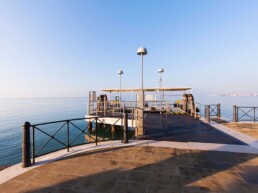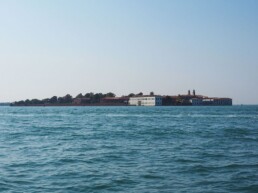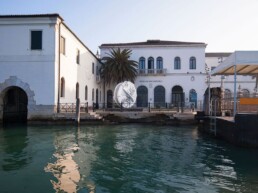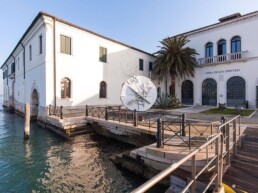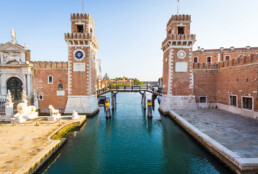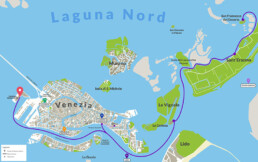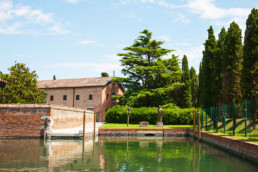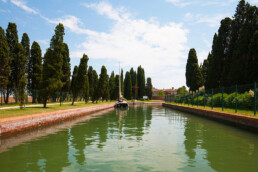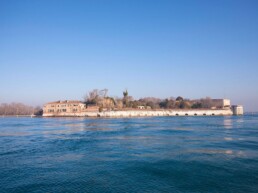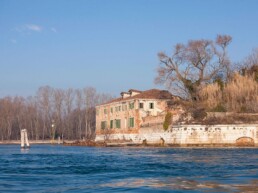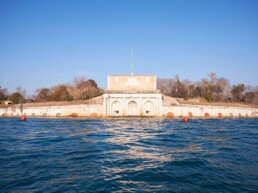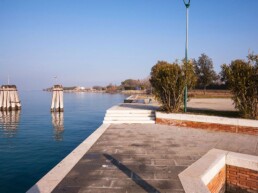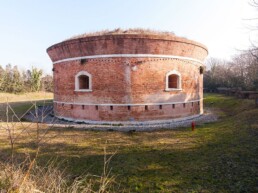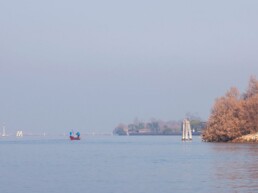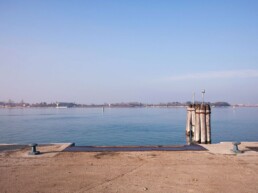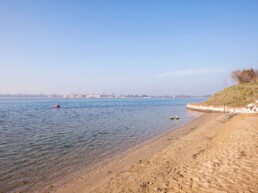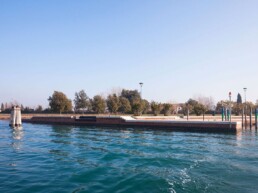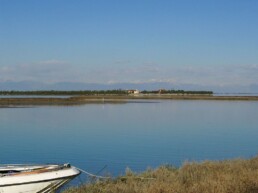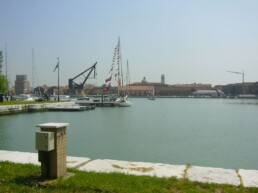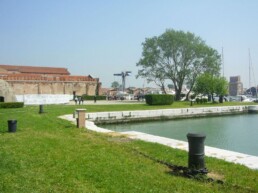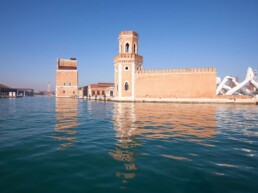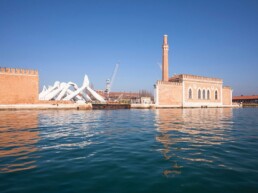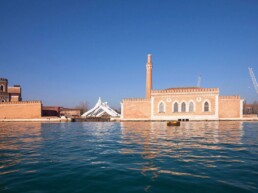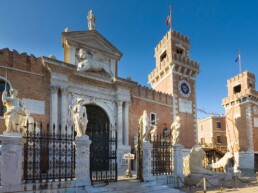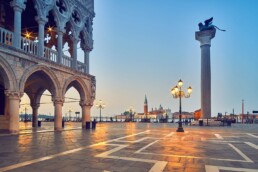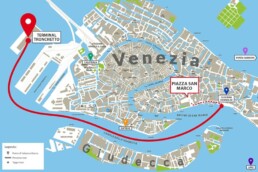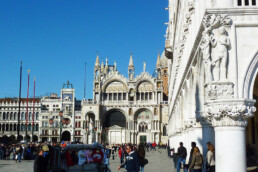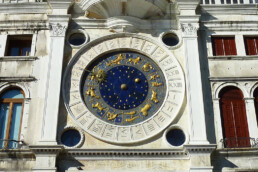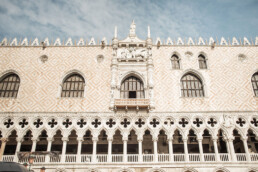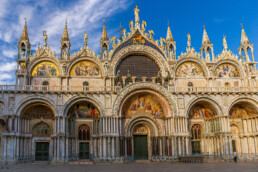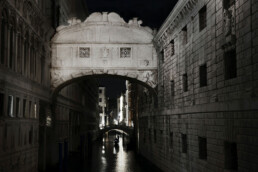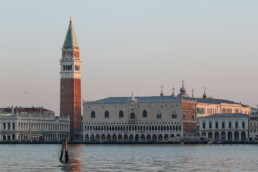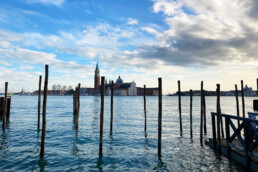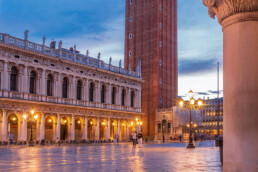Murano glassworks
Murano, island of glass: the tour of the historic glassworks is a journey to discover the secrets of this ancient Venetian art, which is famous all over the world.
Passengers will be greeted by the on-board staff at the agreed boarding point (Tronchetto passenger terminal, Port of Venice,San Marco or Punta Sabbioni, as required), the starting point of our itinerary.
Normally the tour includes departure from the boarding point at Tronchetto with a stop in San Marco in the morning and, in the early afternoon, boarding from San Marco for Murano.
In Murano there is a stop of about 40 minutes and then a return to the Tronchetto Terminal.
However, depending on your needs, it is possible to arrange departure in advance from a different boarding point and customise the itinerary to measure.
The island of Murano developed at the end of the 13th century, when a decree ordered glass artisans to move away from the historic centre to avoid the risk of possible fires. The island got the name of “island of fires” because of the numerous furnaces present and still active today in theartisanal production of quality artistic glass.
The tour includes a visit to one of the island’s furnaces , where it will be possible to witness glass blowing, during which the glass masters put all their ancient knowledge and skills to work.
After the demonstration it will be possible to visit the showroom, where you can buy artistic glass artefacts.
Normally there will be a stop of about 40 minutes in Murano, an ideal duration to allow a visit to the furnaces.
However, in the morning before departure , it is possible to agree on a longertour duration than the standard service.
Those who have chosen to extend their stay on the island will be able to take the opportunity to pay a visit to the Murano glass museum where the memories of this ancient art are preserved today. One of the most precious pieces is the famous Barovier wedding cup from the fifteenth century.
Continuing the walk on the island of Murano you will meet the Church of San Pietro Martire, where the splendid altarpieces by Giovanni Bellini are kept, and the Basilica of Santi Maria e Donato, a masterpiece of Venetian-Byzantine art with its mosaics and a golden dome in the apse.
At the end of the visit the boat will bring the passengers back to the boarding point.
Request Information
To book a service or request a quote without any obligation, you can send us an email or fill out the following form.
The Islands: Murano, Burano and Torcello
Murano
Murano is one of the most famous islands of the Venetian Lagoon, and owes its fame to the skill with which its artisans still work glass.
To date, the origin of the Venetian glass industry is not clear, but one hypothesis connects it to the Venetians who, after learning the Roman techniques of glass processing in the mainland, returned to the Venetian islands and began to produce objects of various kinds.
In 1291, after a decree issued by the Great Council, all the furnaces present in Venice were moved to Murano, thus avoiding the constant risk of fire, which was frequent in a city like Venice. Murano is made up of 5 main islets, while the residential fabric is cut in two parts by a sinuous Grand Canal, crossed by a single bridge. The role of the island in the 1500s was mostly as a holiday destination for the aristocratic families of the time: for this reason it is impossible not to notice the alternation between the palaces of the merchant bourgeoisie and the more modest houses.
The twentieth-century style is most present in the internal construction of the island, while the exposed shores on the lagoon side are scattered with factories that are either still in use, disused and used as warehouses. Inside Murano it is possible to visit the Glass Museum, housed in a historic patrician residence that was the first seat of the municipality of Murano.
It hosts a rich collection of artefacts that were partly donated over the centuries by the master glassmakers of the Murano kilns, testifying to the ancient Venetian glass art.
Burano
The island of Burano is a tiny archipelago of the lagoon. Like Torcello, it was founded by the inhabitants of Altino, who had found in this area a refuge from the invasions of the Lombards, thus giving it the name of Porta Boranea.
There are many special features that you encounter when visiting Burano, one of the most evident being the colour of the residential buildings on the island. Various reasons are given for the bright colours of the facades. Some say that they were used by sailors during days of thick fog to recognise the edges of the city, others say it was for those had to return to their mooring and therefore recognise their home, while still others think it was so they people recognise the families in the city that had the same surname as them.
In addition to being famous for its chromatic vivacity, the island of Burano is also recognised for its great mastery in the lacework with a sewing needle: in fact, outside the homes you will find local ladies focussed on their craft. Burano is home to the Lace Museum, guardian of the secrets and history of this ancient process that made and still makes Burano famous all over the world.
The island’s gastronomic specialty is its golden biscuits, the “bussolà”: made up of butter, vanilla, corn flour and eggs, they can be in the shape of a donut or S. The symbol of Burano is its high bell tower, characterised with a steep slope. As in the other islands of the Venetian Lagoon, in Burano you can breathe an air of serenity and tranquility, thus giving those who visit it the opportunity to forget the hectic passing of time.
Torcello
Torcello is now an island with a mostly rural character. Its most flourishing period at the height of its splendour was from the seventh to the ninth century, when, after being founded by Bishop Mauro di Altino and his community, who were fleeing the Lombard assault in the Roman city of Altino, the island became an important and rich economic centre of the Venetian Lagoon.
Its port, the salt pans and its wool factories were of great renown at the time. After the eleventh century, Torcello was gradually abandoned due to the swamping of the lagoon and was used as a quarry for the buildings of Venice under construction. Upon arriving on the island, in addition to the famous Devil’s Bridge and the small dock, we will find the ancient Basilica of Santa Maria Assunta di Torcello, the remains of its baptistery and the church of S. Fosca.
Walking along its streets, we will also notice not only palaces such as that of the Archive and of the Council, but also curious finds relating to legends, such as the so-called “Attila’s throne”, a marble chair most likely used by the magistrates in charge of the administration of justice at the time.
Nature is the fascinating protagonist of the whole island, enveloping it in a silence and calm that appear almost timeless.
Request Information
To book a service or request a quote without any obligation, you can send us an email or fill out the following form.
Laguna Sud: San Lazzaro degli Armeni, Lido di Venezia, San Servolo
San Lazzaro degli Armeni
The effect that the Island of San Lazzaro arouses is that of a place of peace and culture: when you get off the boat you cross a cobbled square, surrounded by multicoloured flowers. A bronze statue of the founder of the order welcomes visitors, inviting them to engage in silent meditation. An iron gate leads to the cloister, consisting of a portico of round arches.
In the second decade of the eighteenth century, a group of Armenian monks landed on the island of San Lazzaro. Venice had a long tradition of exchange with the Armenians, as an essential basis for trade with the East: a testimony of this choice is still visible in calle degli Armeni, located not far from S. Marco. This area represented the centre of the Armenian community and their Venetian community life.
The Monastery
The monastery complex consists of various buildings that belong to different historical periods but are visually homogeneous in their totality. From the classic central cloister, the Novitiate building branches off to the south-east, the printing house to the west, the Professoio to the north-west and the body of the refectory and the magnificent library in the south-east wing. You enter the church through a corridor located in the eastern portico.
Venice Lido
A strip of land that divides the Venetian lagoon from the open sea, the Lido is divided between beaches and tree-lined promenades, lush gardens and architectural structures from various eras and with different functions. The island is divided into the inhabited centres of Lido, San Nicolò, Malamocco and Alberoni.
Once this stretch of land was populated by princes, dukes and knights who idly awaited their fate here, at the time of the liberation of Jerusalem.
Thanks to its natural conformation and its position, the Lido became the natural defensive system of the Venetian lagoon. In addition to having a military purpose, the island also had a rather rural character, and was cultivated with vegetable gardens and orchards. It inspired a sense of tranquility and thus came to provide hospitality to the greatest European writers of the 19th century. The urban and touristic development following the annexation of Venice to the Kingdom of Italy belongs to this period. This led to the creation of large hotels, villas and buildings such as the Hotel Lido, the Hotel Excelsior and the Liberty-style Grand Hotel de Bains.
Following this urban transformation, the Lido became the most elegant seaside destination in Europe.
This is how you find yourself on this island a few minutes from Venice, catapulted into a place where time seems to have stopped, with its bucolic atmosphere and its cosmopolitan character.
San Servolo
The island of San Servolo was the site of a psychiatric hospital until 1978 and has been a university since 1997. In the seventh century it was the site of a monumental complex of Benedictine monks and from the twelfth century it was used by nuns of the same order until 1615.
In 1725 it passed to the Padri Ospedalieri, now Fate Bene Fratelli. The hospital building was built between 1733 – 66 from a design by Giovanni Scalfarotto. In the courtyard there are some remains of the historic Benedictine complex.
The church is attributed to the architect Tommaso Temanza. Inside there are frescoes by Iacopo Marieschi.
Request Information
To book a service or request a quote without any obligation, you can send us an email or fill out the following form.
North Lagoon: San Francesco del Deserto, Fort Sant'Andrea, Sant'Erasmo, Arsenale
San Francesco del deserto
With a series of cypresses almost closing off its entire perimeter, the island of San Francesco hides itself from the visitor’s view. A solitary place with a spiritual silence, it hosts a community of Franciscan friars dedicated to meditation, work and reflection. It was on this island that in 1220 St. Francis decided to stop and pray when returning from the East and was deeply impressed. This episode, which has been handed down to us by his biographer San Bonaventura da Bagnoregio, was followed by the desire to found a place of silence and meditation right here. Following the donation of the island to the Franciscan friars by the Venetian owner Jacopo Michiel, the current convent of a minor order of Franciscan friars was founded in 1233.
With its convent, its gardens with cypresses, the two cloisters belonging to the beginning of the foundation and the Renaissance period,the island of San Francesco offers an intense introspective experience for all those who wish to get closer to the more spiritual side of the Lagoon.
Forte Sant'Andrea
In the North Lagoon, in front of the Lido port, stands the island of Vignole, at the end of which the Forte di Sant’Andrea immediately juts out. A masterpiece of military architecture, the fortress was built around the end of the sixteenth century according to a design by Sanmicheli and is made up of large blocks of Istrian stone. The artillery of the Serenissima thundered from this fort for the last time in 1797, when the Venetian commander Domenico Pizzamano wanted to oppose the entry of the French ship “Le Libérateur” into the port of Lido, killing the commander Lauger.
Although a long section of the building unfortunately collapsed due to the corrosive and disintegrating action of the waves’ motion on the foundations, from the lagoon it is still possible to admire the central door and the two side arches in equal measure, which are distinctive of San Michelian architecture. As the toponymy recalls, the island’s remaining strip of land is dedicated to horticulture and therefore rich in cultivated fields and scattered houses.
Sant'Erasmo
The island of Sant’Erasmo is located in the centre of the Murano, Burano and Punta Sabbioni Islands.
Used during the Middle Ages as a service port for the islands of Murano and Torcello, it rises between the mouths of San Nicolò and Treporti, thus acting as a dividing coastline between the lagoon and the Adriatic. Sant’Erasmo is territorially larger than all the islands in that area, and is commonly called “the vegetable garden of Venice”, thanks to the rich agriculture it developed over the centuries. Its artichokes, cardoons and asparagus are famous. Its production of wine was also significant thanks to the numerous vineyards that occupied a large part of the agricultural territory.
Despite the numerous plots of land, on the island it is possible to visit not only the church of Cristo Re but also the Massimiliana Tower, a recently built military structure. It was built during the French and Austrian occupation with the aim of defending the lagoon by exploiting its strategic position. Today Sant’Erasmo is an island immersed in colours and nature, a quiet place away from the liveliness of nearby Venice.
Arsenale
The Arsenal is a complex of shipyards, workshops and warehouses from which the Venetian ships – the basis of the political and military power of the Republic of Venice – set sail.
It was first a peripheral place then a highly specialised production centre for the construction of commercial and war ships.
It occupies about 46 hectares in the eastern part of the city. It is defended by a wall that encloses the warehouses and buildings.
The houses of the workers and collateral businesses were placed around it. Arsenal derives from the Arabic “darsina-a”, meaning house of industry, which later became Darsena.
It was built at the behest of Doge Ordelaffo Falier in 1104. It was progressively expanded with a series of construction sites to the north, whereas the west area was used for the gunpowder department and then, after a fire, it was transformed into the galley department.
In the second half of the 19th century the changing needs of the navy led to a drastic upheaval within the “arsenal” enclosure with the creation of three new dry docks.
During the Second World War, anti-aircraft shelters were built in reinforced concrete. The land portal of the Arsenal dates back to 1460. It was attributed to Antonio Gambello and looks like a triumphal arch.
Request Information
To book a service or request a quote without any obligation, you can send us an email or fill out the following form.
San Marco
The most classic of the itineraries, in the heart of Venice: Piazza San Marco is a place full of beauty and charm, the fulcrum of history, art and culture.
Our itinerary begins at the Tronchetto Terminal (possibility of departure from the Port of Venice or Punta Sabbioni, according to requirements) where passengers will be welcomed by our staff, who will assist them in the boarding phases.
After disembarking in Piazza San Marco, passengers will be free to visit it independently.
Piazza San Marco owes its name to the Basilica of the same name, which was built starting from the 9th century. The beating heart of Venice as well as the political and religious centre of the city, once the square was the city’s only entrance from the sea.
Piazza San Marco is trapezoidal in shape, closed on the long sides by the Procuratie Vecchie and the Procuratie Nuove. The Procuratie Vecchie, designed by the architects Sansovino and Codussi, extend along the north side of the square. They are two-storey arcaded buildings, of Renaissance origin, and get their name because the procuratie of San Marco once lived there.
The Procuratie Nuove are now the seat of the Correr Civic Museum, the Museum of the Risorgimento and the Archaeological Museum, which houses a precious collection of Greek marbles from the Grimani family; Napoleon added the wing of the same name to them.
The Doge’s Palace was the political seat of the Serenissima Republic, residence of the Doge and of the highest offices of the state. A splendid example of flamboyant Gothic style, the palace is perhaps the highest expression of Venetian art. The interior spaces, frescoed by the likess of Tiziano, Veronese, Tiepolo and Tintoretto, are worth a visit.
In the courtyard you can admire the famous Scala dei Giganti, a masterpiece of Renaissance art.
Next to the Doge’s Palace is the Basilica of San Marco where it is possible to visit the palatine chapel and the mausoleum of the patron saint. The Basilica is in Romanesque-Byzantine style and has a five-domed roof. The façade, from which five portals open up, is decorated with precious marbles and mosaics. The most famous are those that decorate the atrium and represent stories from the Bible.
Those who want to can climb up the San Marco bell tower, which is located next to the Basilica and once served as a lighthouse for sailors.
At the end of the visit, at the point of disembarkation in San Marco (Riva degli Schiavoni – Pontile Cornoldi), passengers will find a boat waiting for them that will take them back to the boarding point.
Request Information
To book a service or request a quote without any obligation, you can send us an email or fill out the following form.


